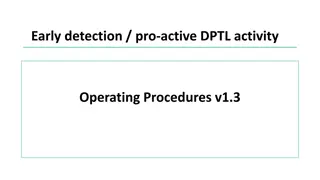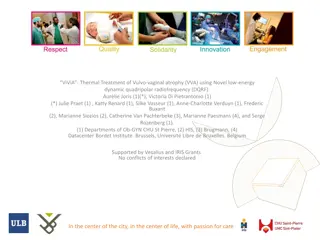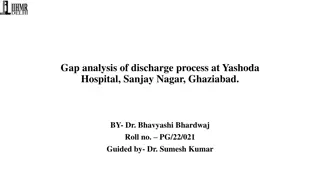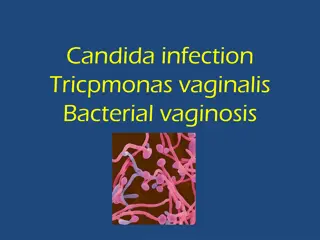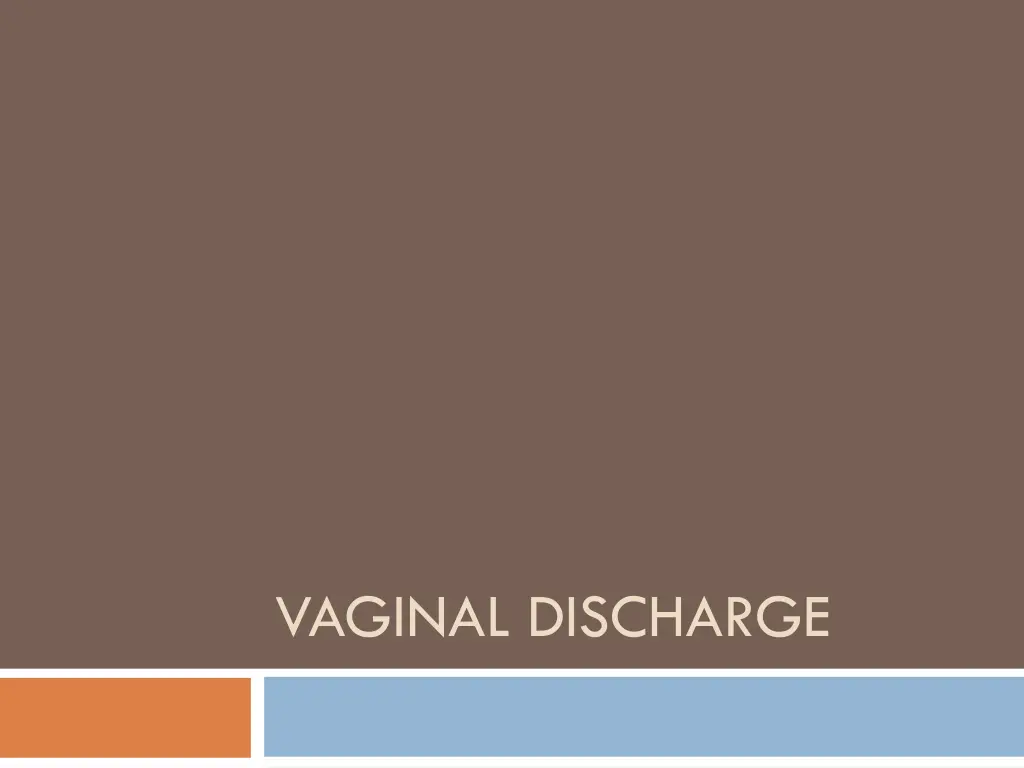
Understanding Vaginal Discharge and Natural Defense Mechanisms
Explore the components of vaginal secretions, the flora of the female genital tract, vaginal pH, and the body's natural defense mechanisms. Learn about the physiological factors that can lead to increased vaginal discharge in various stages of a woman's life.
Uploaded on | 0 Views
Download Presentation

Please find below an Image/Link to download the presentation.
The content on the website is provided AS IS for your information and personal use only. It may not be sold, licensed, or shared on other websites without obtaining consent from the author. If you encounter any issues during the download, it is possible that the publisher has removed the file from their server.
You are allowed to download the files provided on this website for personal or commercial use, subject to the condition that they are used lawfully. All files are the property of their respective owners.
The content on the website is provided AS IS for your information and personal use only. It may not be sold, licensed, or shared on other websites without obtaining consent from the author.
E N D
Presentation Transcript
Vagina Fibromuscular tube communicating uterine cavity with the exterior by the intriotus at the vulva Lined by stratified squamous epithelium without any secreting glands, consisting 4 layers Superficial, intermediate, parabasal and basal layer Is under the influence of estrogen and progesterone
Components of vaginal secretion Secretion from the sweat and sebaceous glands of vulva and the bartholin gland The transudate of the vaginal epithelium and the desquamated cells The mucus secretion of the endocervical glands The endometrial glandular secretion Secretion from fallopian tubes
Flora of the female genital tract In healthy female Fallopian tubes, uterine cavity and cervical canal are free from organism Doderlein bacilli is the only organism found in upper 2/3rdof the vagina Large gram +ve sugar fermenting bacteria and normal habitant of vagina
Vaginal pH - Mature vaginal squamous cells produce glycogen under the influence of estrogen Glycogen is liberated in the process of continuous break down of these cells Glycogen is converted into glucose and lactic acid by the Doderlein bacilli and maintains acid vaginal pH Normal vaginal pH 4.5-5.5
Natural defense mechanism of the vagina Tough stratified squamous epithelium, no glands No crypts as in endocervix, so organism cannot remain in the crypts Low pH unfavorable for bacterial growth Defense mech is low during mens when pH is alkaline due to blood, cervical and endometrial discharge, after abortion and labor, Excessive cervical discharge in endocervicitis
Physiological increase in vaginal discharge Increased vaginal secretions occur normally at puberty ( vascularity), premenstrual phase ( secretions from endometrial glands, vascularity) At the time of ovulation Pregnancy( vascularity)/puerperium At the time of sexual excitement Conditions causing pelvic congestion
Leucorrhea Normal vaginal secretion in increased amount No excess leucocytes Microscopically and macroscopically nonpurulent Cervical conditions- chronic cervicitis, ectropion (everted cx) erosion (columnar cells in the ectocervix) Vaginal pelvic congestion
Abnormal vaginal discharge Excessive vaginal discharge needs wearing of extra absorbent pads, clothes, tampons, diaper Associated with other symptoms or signs eg blood stain, yellow colored, pus like and foul smelling Itching, excoriations and ulcerations in vulva pain abdomen, fever, urinary symptoms
Evaluation of Vaginal Discharge Pathological or physiological ? History- amount, onset, color, odor, consistency Clinical examination complete inspection and examination of external genitalia, speculum examination to inspect vaginal walls, posterior fornix, cervix and nature of discharge swab coleection from the posterior fornix for c/s, hanging drop preparation, saline examination endocervix, urethral swab if gonorrhea suspected
Vaginitis Specific Non specific
Specific causes of vaginitis Trichomonas infection Candida infection Bacterial vaginosis
Trichomonas vaginalis Very common Common in women of child bearing age Sexually transmitted Sometimes by using infected towel, clothes Favored by lowered general resistance and alkaline vaginal pH 5-6 (during period)
Contd Actively motile protozoa, slightly larger than a leucocyte and anaerobic 3 types- buccalis (mouth), hominis (anal canal and rectum), vaginalis (vagina) Buccalis and hominis are unable to survive in the human vagina Men harbour Tr vaginalis in prostate and urethra
Symptoms and signs Increased discharge with itching Burning urination, dysuria, frequency Inflammation of vulva, excoriations Profuse vaginal discharge, thin, creamy or slightly green, frothy and irritating Vaginal walls are tender Multiple small punctate strawberry spots on the vaginal vault and the cervix
Investigation A fresh wet film preparation and M/C examination Recognized by its constant motion and flagella, adherent to a squamous cell or pus cell Culture in special media in which antibiotic has been added to inhibit other organisms (Feinberg Whittington medium) Can be diagnosed in a smear for cytology
Treatment Metronidazole 200 mg Tds X 7 days or 500 mg bd X 7 days for both partners, or 2 gm single dose No intercourse or condom use during therapy Alternatively Tinidazole 500 mg BD for 7 days or 2 gm stat Vaginal pessary metron+ clotrimazole
Vaginal Candidiasis (Moniliasis) Gram +ve fungus- candida albicans Flourishes in acidic pH and abundant carbohydrate supply Conditions which favor infection by this organism are- Pregnancy ( vag acidity, glycosuria) Diabetes ( glycogen, glycosuria) Patients on antibiotics, Oral contraceptive pills, steroids, immunosuppressive therapy
Symptoms and Signs Symptoms- profuse discharge, intense pruritus, soreness and edema of vulva, dyspareunia Signs Red, swollen vulva, excoriations Reddened vaginal wall Thick curdy discharge, white patches or plaques of cheesy material adherent to vagina, when removed hemorrhagic area seen
Diagnosis Wet smear of vaginal discharge prepared by adding 10% KOH sol and M/C exam Filamentous form of mycelia, pseudohyphae seen Culture on Sabouraud s or Nickerson s media
Treatment Local fungicidal preparations in tablet form, or gel Clotrimazole vag tab/pessaries X6days Others miconazole, Mycostatin, Nystatin vaginal pessaries 100000 units1tab hs X 14 days Oral Fluconazole 150 mg stat Itraconazole
Treatment contd Nails should be clipped to control source of infection Intestinal infection suggested by perianal itching treated with oral dose, Fluconazole 50 mg for 7 days Can repeat the dose if not relieved or Treat partner
Bacterial vaginosis Gardenerella vaginalis and organisms of other species like bacteroides, peptococcus, mobilincus, mycoplsma hominis Gram -ve bacilli C/O Excessive vaginal discharge, with foul odor Minimal or no vulval irritation
Diagnosis -Amsels criteria (4) White homogenous vaginal discharge Vaginal pH- alkaline (litmus paper test) Clue cells > 20%(epithelial cells with granular cytoplasm caused by adherent bacilli) Whiff s test +ve- pungent odor due to release of ammonia when a drop of discharge is mixed with 10% KOH sol (OR) HVS culture
Clinical implications PROM Preterm labor Chorioamnionitis, Endometritis Recurrent infection may cause PID PID following abortion Vaginal cuff cellulitis following hysterectomy
Treatment Metronidazole 200mg thrice daily or 500 mg BD 7 days or 2 gm stat Secnidazole 2gm stat Clindamycin 300 mg BD X 7 days Clindamycin cream vaginallyX 7 days Metronidazole cream vaginally Treatment of the partner
Non-specific vaginitis Alteration of pH towards alkalinity favors non- specific infections- eg puerperium, post abortion Mixed pathogens in smear or culture staph, streptococcus and anaerobes, E coli Chemicals/ drugs/douches/tampons/foreign bodies
Symptoms /signs Mild or severe, acute or chronic presentation Irritation, discharge, smelly, yellowish Burning, dysuria and frequency Red swollen tender vagina, profuse yellowish discharge Diagnosis by smear and culture
Treatment General measures- improve general health of the patient Local- bactericidal cream , vaginal psessaries Antibiotic according to organism and sensitivity (oral or vaginal) Elimination of reservoir of infection in the genital tract such as chronic cervicitis by diathermy
Estrogen deficiency vaginitis Vulvo-vaginitis in children and senile vaginitis in postmenopausal women Thin vaginal epithelium, ill protected against infection, glycogen content is low, doderlein bacilli is thinly populated vaginal pH is higher than normal 7.4 or more
Senile (Atrophic) vaginitis Vagina is inflamed sore edematous, excoriation of skin, purulent or blood tinged discharge, frequency and dysuria Vagina is patchy red , bleeds on taking swab Infection may spread upwards endometritis
Management Exclude endocervical and endometrial Ca or pyometra Treatment Oral estrogen Local estrogen cream or tab
Vulvo-vaginitis in children Common age group- 1st5 years or any age before puberty Estrogen deficiency Foreign body Threadworm Non specific infections
Infecting organisms- gonococcal, strepto/ staphylococcus or E coli, trichomonas or candida rare Transmitted by infected adults/ another child by hands, clothes
Diagnosis by symptoms and signs, EUA, swab culture Treatment- Perineal hygiene Estrogen cream Antibiotic if culture +ve
SUMMARY Vaginal discharge differentiate B/W normal and abnormal by Symptoms/Signs- specific to organisms, investigations if want to confirm , otherwise treat the cause Nonspecific vaginitis cause according to S/S, age group, treat accordingly


